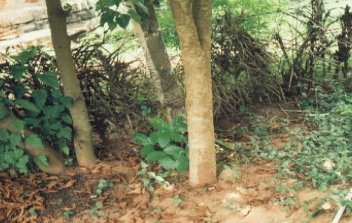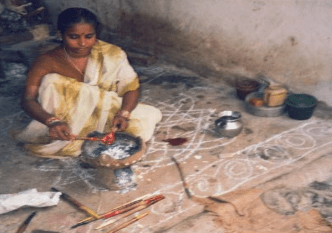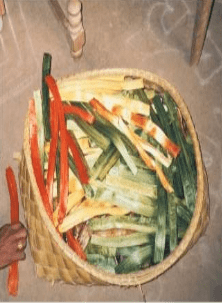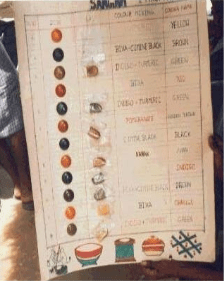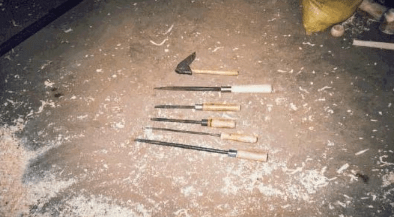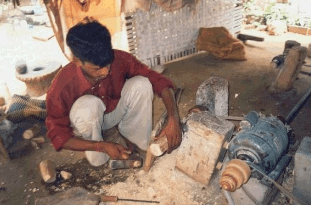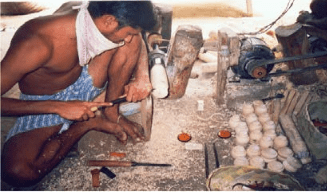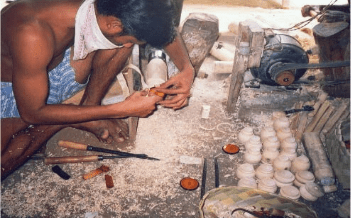The craft of making wooden lacquered objects goes back many generations. It is said to have been practiced from 300 BC. Toys, ornaments, images of god and decorative pieces made from softwood and brightly colored with lacquer have come to be famous for their skillful craftsmanship.
Etikoppaka toys
In the town of Etikopakka in Andhra Pradesh, as in Chennapatna, Karnataka, local craftsmen make these eco-friendly products with local resources. Earlier mostly natural dyes were used in the process;later on due to scarcity the craftsmen shifted to chemical dyes.
However in recentyears they have again shifted to natural dyes due to the demand for eco-friendly materials. Etikoppaka has an age-old tradition of toy making. The toys are usually made of a soft wood. Etikoppaka is famous for the toys made with ‘Ankudu’ wood.
The tools used are primitive. It is a wonder that with these tools, objects of such skill originate here. The wood is seasoned and cut to suitable length. It is turned on lathes, and then coloured lacquer is applied and burnished to a high gloss. The piece is then cutoff the lathe and the product are ready.
Region
The craft is mostly concentrated in the surrounding villages of Ye
llamanchili in Visakhapatnam District in Andhra Pradesh. Lacquer toys are mostly made in Etikoppaka, Kottam, Kailasapatnam, Rolugunta, K.D.Pet villages. Among these Etikoppaka is the most famous as most of the craftsmen are based in this village.
These toys are locally also known as ‘Etikoppaka toys’. Etikoppaka is 100 kmaway from Visakhapatnam. Situated on the left bank of the river Varaha, 20kms to the south of Yellamanchili, Etikoppaka is a large village with a population of around 12,000.
More than200 artisan families in this village are engaged in toy-making. In the post-independence period, lack of demand in the local markets and low prices forced the artisans to migrate to urban areas.
Producer Communities
Most of the artisans practicing this craft belong to Vishwa brahmin, Devanga, Gouda, Padmasali, Konda, Setty baliga, Kapu castes.
Raw-materials used
Wood: The main raw materials used in making these wooden toys are Ankudi Karra (Wrightia tinctoria) and lac.
Ankudi
Karra is a soft wood that grows abundantly in the local forests, located 30-40 km away from Etikoppaka. Small toys are made with branches. For larger and heavier toys, the trunk of the tree (usually between 4-5 inches thick) is used. After cutting the tree, it is stored for 3 months in shade to let the moisture evaporate.
Lac:
There are two different types of lac
Rangeen and Kusumi. The latter is considered to be of higher quality, is lighter in color and demands a higher price (almost double), though it has a longer time cycle. The tree itself could take as long as several years to grow.
Palas or Flame of the Forest is the major host tree. Pruning is in April –May and there is usually a rest of 6 months after that. There are about 30 parasites of the lac insect and these are responsible for 5-10% damage, though the major damage is due to predators (about 30 – 40%).
After pruning the lac is scraped, crushed, washed in a tub, dried and then sieved for grading.
Natural dye/colour preparation:
There are specific procedures for preparing different dyes. The raw material derived from different parts of various trees or plants is powdered and boiled to form a thick solution till it starts producing lather. The concentrates are then filtered.
The colours and shades depend on various factors such as the temperature at which it is boiled, duration of boiling, quantities of water and raw material boiled.
For instance, to prepare a concentrate of red or orange, one kg seeds of Bixa orenella are mixed with two liters of water and boiled on a small domestic stove for twenty to thirty minutes.
The concentrate is cooled and filtered to mix with lacquer. However, some colours have complex and systematic processes of preparing the concentrate.
The commonly used natural dyes are mostly prepared from local resources. Locally available leaf, bark, seeds, flowers, and skin of fruits are used in preparation of the dyes. Some artisans also procure from Chennai and Bangalore.
The following colours are obtained naturally from the materials mentioned below:
Anar – yellow
Kattha– Brown
Annatto seeds -Yellow
Chavalakundi– Pink
Indigo– GreenIndigo
Crystals – Indigo Blue
Kasim – Black
A new colour range has been developed using chemical colours but without Titanium-di-oxide. Artisans’ Wing has also developed a colour range for the export market using food colours.
According to an elderly artisan in Etikopakka, before 1910 the dyes were made from a tree called Divi–Divi (Caesalpinia coriaria). From this tree, the artisans could get only the color red in different shades. This tree has become locally extinctnow.
After 1910, synthetic dyes were introduced in the market, replacing the traditional practice of using tree-based dyes. These were available in wide ranging colours. However, when they were used, it was necessary to add another chemical, Titanium dioxide while mixing with lacquer.
Tools used in toy making are as follows:
Lathe machine
Badithi(Axe shaped)
Five types of chisels locally known as Vuli(They are
a) GoruChisel,
b) ManuChisel,
c) Low Chisel,
d) Kuja Chisel,
e) PogaruChisel)
Emery paper
Mogali Aaku (the leaves of a particular tree)
Tools
The production process and the tools used are described below.
5.1 Lathe Machine:
Hand lathes are now increasingly replaced by electric lathes, with designs or dolls’ features being painted on later by hand.
This lathe machine is fitted between two crossed wood pieces. The lathe machine is run on a 1HP motor and is connected with a belt. One side of the lathe machine is fitted to the crossed wood. On the other side is fitted the raw wood to be shaped. The lathe machine is the main tool on which designs and polishing work are done with the help of different chisels (vuli).
5.2 Badithi (Axe shaped tool):
This is used to scrape one end of the wooden piece in order to fit it into the lathe machine.
5.3 Chisels:
5.3.1 Goru Chisel: (nail–shaped chisel)
This chisel is made of iron and has two sides. One side fits the crossed wood (mentioned earlier) and the other side bears the shape of a nail. This chisel is used forgiving shapes and curves to the product being made.
5.3.2 Manu Chisel:
This is a rectangular shaped chisel, used for cutting and shaping wood.
5.3.3. Low Chisel:
This is similar to the nail-shaped chisel, specifically used to make holes in the products.
5.3.4 Kuja Chisel & Pogaru Chisel:
These are two similar tools used for small carvings.
5.6 Emery Paper:
This paper with crystals on one surface is used for smoothening the semi finished product before applying colours.
5.7 Mogali Aaku (a fragrant leaf)
These leaves are mainly available in coastal areas of Andhra Pradesh (namely Vishakapatnam). These leaves are first dried in the sun and then used for final finishing (polishing) of the product. This polishing is done after applying the colours.
Production process
The raw material (wood) brought from the forest is seasoned and cut to suitable length.
This wood is put on the lathe machine for smoothening. With the rotation of the lathe machine, the artisan shapes and designs products with the help of different carpentry accessories.
The product is then given suitable colours.
Lacquering is done on the lathe, hand or machine operated. For making slender and delicate items, the hand lathe is considered suitable.
Dry lac is pressed against the item to be lacquered, while it is on the lathe. The friction-generated heat melts the lac.It speaks of the skill of the craftsman that he uses different colors and yet manages to get a uniform shine on them.
Final finishing& checking of the craft:
Before the products are dispatched for sale or to the market they are inspected. The final product is checked for blemishes such as rough finishing, shade variations, any breakages, etc., which are then rectified.
Design
In making new designs, Etikoppaka artisans are helped by the School of Fine Arts, Andhra University; the National Institute of Design, Ahmedabad; and M.S. University, Baroda, besides individual designers.
Dastkar Andhra was instrumental both in developing new designs and also in introducing Shri K V Chandramouli, the natural dyes expert, to Etikoppaka. Shri Chandramouli taught the artisans how to use natural dyes mixed in the lac.
As mentioned earlier, the artisans can achieve considerable variation in design with the help of the various chisels at their disposal. Designs vary from product to product. At times, designs are specifically mentioned if there is a big order.
The designs currently being made are a product of any of the following:
a) The artisans’ own creation
b) Customers’ requirements
c) Market feedback
The artisans also get design inputs from certain crafts magazines and journals, which give them pointers for colors and features.
Products and their uses
There are a wide range of lacquer-ware products, which can be used for various products. Toys, decorative items, images of gods, candle stands, oil bottles, cups, ornaments, photo frames, jewelry boxes, bangles and bangle stands are some of the popular products. There is a wide range of toys for children of all age groups.
Primary market
Orders from handicraft show rooms throughout India: for instance, Lepakshi showrooms and other crafts shops. Etikopakka toys and other products are also exported to America, Australia & European countries. Within the Indian market, sales are also done through exhibitions across the country.
Developmental Changes
This craft has undergone a lot of developmental changes in relation to technology, market and design in particular. The use of natural colours and their combinations has brought in great design innovations and quality at reasonable rates. Technological changes have made craftsmen switch to lathe machines instead of handwork, which saves time and man power.
Problems faced by the craftsmen
Three factors that currently limit the proper development of this toy industry at Etikoppaka are:
a) Production has not been re-oriented sufficiently to suit the present day market and the designs required
b) Predominance of middle men on whom the artisans depend entirely for credit and marketing
c) Lack of extended and direct marketing facilities
Another major hurdle is the availability of the wood Ankudu (Wrightea tinctoria) used in making toys. The Forest Department had been imposing a fine on these artisans. There is no legal means of obtaining wood directly from the forest other than buying from the vendors. Each member had to pay Rs 10/- a month as a tax in the past, irrespective of whether the artisan used the wood from the forest or not.
The Forest Protection Committee is tackling this problem through plantation of this species over the last four years. Another difficulty is the storage of wood. The wood sometimes develops cracks even when necessary care is taken. Once the wood develops cracks, it cannot be used and the investment is a waste.
Another hindrance for the artisans in Etikoppaka is the absence of regular power supply to run the lathes. Etikoppaka gets power effectively only for six hours during the day. This reduces the total man-hours of work. Working in the nights not only affects the artisans’ health but also the quality of the product.


